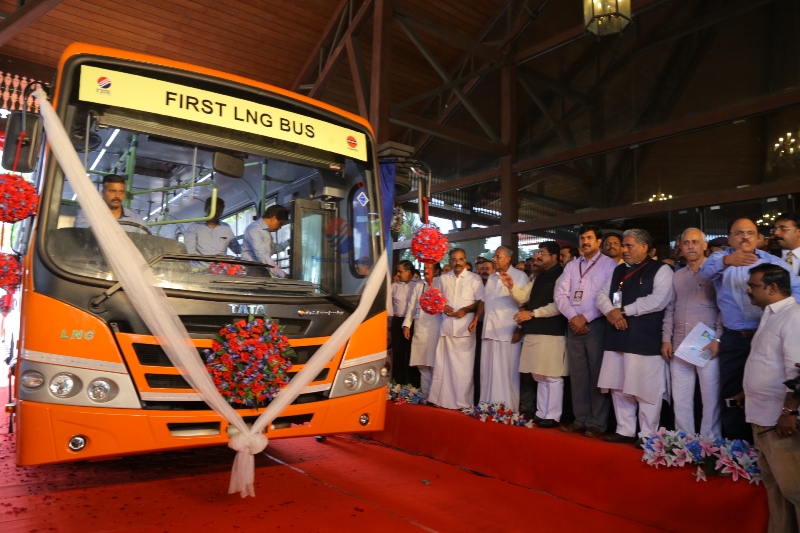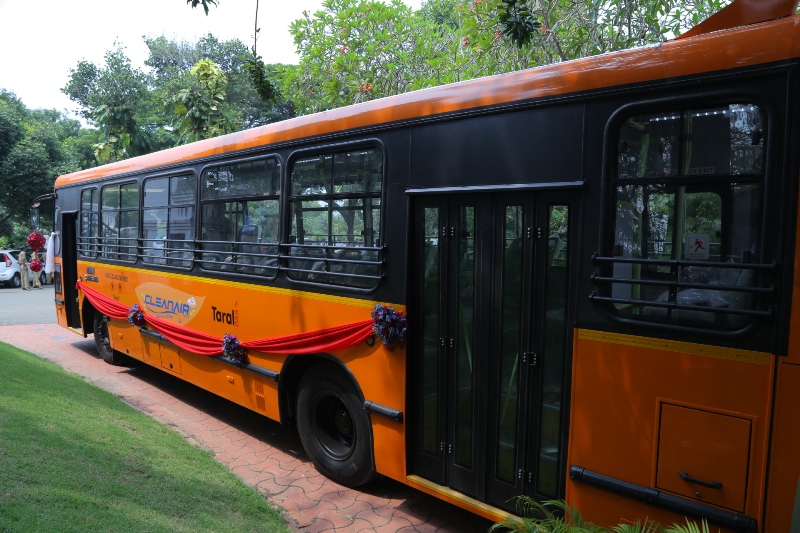Showcases country’s first LNG-driven bus in Kerala
Tata Motors has recently showcased the country’s first LNG (liquefied natural gas) powered bus in Kerala, in the presence of Hon’ble Minister of Petroleum and Natural Gas, Shri Dharmendra Pradhan and Hon’ble Chief Minister of Kerala Shri Pinarayi Vijayan.

With India expected to see an increase in demand for LNG over the coming years, owing to increased demand from the power, fertilizer and automotive sectors, the government plans to move towards a gas-based economy, with Kerala as the first state to explore trial run of LNG-driven technology.
Mr. Ravi Pisharody, Executive Director, Commercial Vehicles, Tata Motors said, “We at Tata Motors are proud to showcase the country’s first LNG bus, our gas-fueled people mover. As one of the country’s largest bus manufacturers, the Tata LNG bus is based on the Tata Motors understanding of the various transport authorities for public transport, creating a win-win situation for all stakeholders, for clean, safe, affordable and comfortable commuting. With LNG, we are not only FUTUREADY, but are extending that capability towards the energy security of our nation.”
Tata Motors has pioneered the introduction of Natural gas vehicles (CNG) in the country, with a large fleet of buses running in various parts of the country. Tata Motors LNG powered Tata LPO1613 bus, is lighter in weight compared to buses powered by conventional fuels, and has enhanced levels of payload. Moving towards gas power, will not only contribute majorly towards decreasing emissions for a cleaner environment, but will also ensure better fuel efficiency, due to high energy density of LNG, providing for a longer range at more than 700km in one filling. LPG powered vehicles also ensure better Noise Vibration Harshness (NVH) characteristics for passenger comfort.

With growing availability of LNG at a cheaper cost, as compared to HSD (High Speed Diesel), LNG also lowers the operating cost of vehicles, further enhancing the efficiency of operators. High energy density and liquid form allows LNG to be stored in smaller size cylinders with a packaging that’s similar to diesel fuel. LNG is also a cleaner fuel and reduces greenhouse gas emissions by 30% with respect to conventional liquid fuels. LNG system operates at lower pressure and also evaporates quickly, given that it is lighter than air and hence evaporates extremely quickly under atmospheric pressure and temperature, hence safer. LNG will also help reduce the dependence on expensive crude oil. Tata Motors first showcased LNG technology on the Tata PRIMA Truck, at Auto Expo 2014 in New Delhi.
Following the event in Kerala, we had a detailed discussion with Dr. A.K. Jindal, Head – Engineering Commercial Vehicles, Tata Motors, to know more about the specification and use of the LNG bus in India.
Excerpts:
What led you to develop the LNG-powered bus for India?
We have been producing CNG buses for a long time now. However, the proliferation of CNG at many places has not been possible because of the low availability of CNG stations. There is a lot of interest in LNG across the world, and India is also importing a lot of LNG from Katar and other sources. However, it has not been still used as an automotive fuel for vehicles. As the environment concerns get stronger after each passing day, we at Tata Motors think that LNG could just become a strong contender as an alternate fuel for commercial vehicles. We have been working on this front since 2014 when Tata Prima LNG was first showcased. The Tata Star Bus showcased here in Kerala is our standard 12 metre bus with 130 hp-powered by LNG cylinder with a carrying capacity of around 50 passengers. For the LNG infrastructure we are working with Petronet LNG and IOC.
While the availability of CNG stations in itself was a challenge, how confident are you that LNG will be a viable option for STUs and transporters?
A look at the global trends will tell you that LNG is going to be the future fuel. Worldwide there is a prediction that by 2020 10 per cent of transportation will be on LNG-powered vehicles. China already is in the forefront and thousands of vehicles in the US and Europe run on LNG. Conditions in India are now favorable for its use in the transportation sector as availability is no longer a constraint. We are trying to leverage infrastructure that has already been developed along the west coast of Kerala, right from Gujarat. LNG is also cheaper than diesel to the tune of nearly 30-40 per cent as well as CNG which is 15 per cent dearer. It can add a lot of value to the customers as well as the entire industry. The cost of ownership will come down. With LNG our customers will be able to utilize their fleet more efficiently.
How soon can we see a truck on LNG running in India and what will be the difference in terms of mileage and kilometers travelled on the LNG cylinders compared to CNG?
Whatever trucks that we have can be easily converted into LNG. We are working on gas engines of higher power. While buses will be available by April 2017, trucks will only come by the end of next year. Since LNG can be packaged in small cylinders due to its high energy density and liquid form, the carrying capacity of commercial vehicles will be twice as much as what CNG can manage. It can go up to 600-700 km in one filling which is at least 1.5 times higher than the CNG-powered vehicles.
What is the strategic way forward to convince STUs of the need to opt for LNG?
The Kerala State Transport Corporation wanted 1,000 CNG buses but is ready to pilot with 100 LNG buses after seeing our efforts. I am sure the results in terms of economical advantage will speak for itself and other STUs will also take cue from it. We expect that trucks powered by LNG will gain momentum once the buses lead the way and that the transporters are convinced of its benefit. Also there is hardly any difference between the engines for CNG and LNG and hence switching over will not be an issue.
